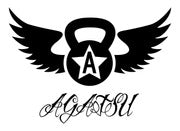
Why You Should Be Offset Training
By MARIO LIZÉE, Senior Agatsu Instructor
Offset Training. Not everyone is familiar with the concept, but everyone should as it is an excellent way to build strength and stability that will not only increase athleticism, increase your overall strength and stability, but also transfer well to daily life applications and injury prevention.
Just think of picking up your child and carrying him/her on one side, carrying grocery bags, or a heavy box on your shoulder, I could go on and on. Our daily lives are filled with movements where load is unevenly distributed. And that is where offset training comes in. The idea is simply to load more (either weight or tension) on one side of the body. This can be achieved with barbells, kettlebells, dumbbells, steel mace, clubs, cables, bands or bodyweight.
As a parent, you never know who, how and when
someone will decide to hitch a ride. Offset training keeps you ready and resilient for whatever life throws at you.
What are the benefits of offset training?
- Address and correct imbalances and asymmetries by efficiently targeting specific muscles
- Increase core strength and stability
- Cleaning up body movement mechanics by developing good form and functional range of motion
- Increase intramuscular tension and neural drive
- Develops mental toughness and focus
- Enhance coordination and motor control
- Changes the dynamics and challenges of familiar exercises by adding instability
- Increases the difficulty and effectiveness of lighter loads
- Practical for sports and everyday life
There is a vast array of exercises that can be performed as offset training. But in order to keep things simple, I will give you a few here that can be achieved with minimal equipment.
A simple way to put these in your training and gain strength in that position is to pick a weight that will challenge you for 3-5 sets of 5 reps. If you only have access to a lower weight, then go for anywhwere between 8-12 reps per set. For the loaded holds and carries, go for 3-5 rounds of 30-60 seconds.
1. Suitcase Deadlifts or Mace Offset Deadlifts
For the Suitcase deadlift you can use just about anything (ie: kettlebell, big jug full of sand, barbell, dumbbell, etc.) Grab the object, as you would pick up a suitcase, making sure to keep proper alignment of your spine and the stand up, while staying as level and vertical as possible. Tighten your care, and try not to let your body sag on the heavy side, or lean the opposite way to compensate for the weight.
Suitcase Deadlifts
For the offset deadlift you can use different implements like a steel mace, a sledgehammer or a barbell loading on one side only. You set up, the same way you would for a classic deadlift and you focus on maintaining a proper and level spinal alignment throughout the movement. Once again, the idea is to tighten your core to stand tall and straight without leaning to either side.
Offset Steel Mace Deadlifts
2. Offset Front Rack Squats and Presses (Thrusters)
Here are two variants of a very common exercise, the Thruster. Basically a squat combined with an overhead press. A great compound movement that works the body from top to bottom. But here, instead of loading evenly on both sides, you put all the weight on one side of the body. This will force you to stabilize in order to stay straight. The steel mace variant allows you to put even more offset load by placing the weight away from your body.
Single Kettlebell Front Rack Squat to Press
Offset Steel Mace Squat to Press
3. Offset Rows
Rows are great. You train your arms, your back and by loading in front of you and working from a standing inclined position, you are making your core work. By doing the single arm version, you are also working anti-rotation as you resist the force pulling you on one side. Try it with a steel mace and feel the burn as the leverage brings your anti-rotational force output through the roof!
Single Kettlebell Rows
Offset Steel Mace One Arm Rows
4. Offset Carries
Carries, some of the simplest and most day to day applicable movements. Pick something up, hold it, carry it, walk around with it, etc. For the offset version, pick something up on one side, just like you would carry a child one arm, or carry your one overly filled grocery bag. Then engage your whole body in staying straight. From there you either try to hold for time, not letting yourself sag in any way, or you walk. You can go for distance or time. When I train indoors at home, I like to walk around randomly in a small space to feel the effect of te weight as I walk forwards, backwards, pivoting and turning.
Suitcase Holds
Offset Racked Kettlebell Walking Carry
There is so much more that you can train and experiment with in offset training, depending on your goals. I find that these are good starting points for just about anyone though.
Train safe, train smart, have fun!

Leave a comment